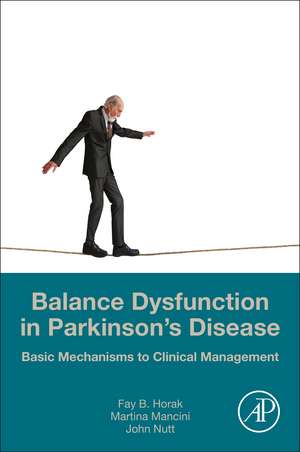Balance Dysfunction in Parkinson’s Disease: Basic Mechanisms to Clinical Management
Autor Martina Mancini, John G. Nutt, Fay B. Horaken Limba Engleză Paperback – 16 sep 2019
In addition, the book's authors summarize the effects of levodopa, deep brain stimulation, and rehabilitation intervention for each balance domain. This book is recommended for anyone interested in how and why balance control is affected by PD.
- Provides the first comprehensive review of research to date on balance dysfunctions in Parkinson's disease
- Discusses how to translate current neuroscience research into practice regarding neural control of balance
- Provides evidence on the effects of current interventions on balance control
Preț: 667.30 lei
Preț vechi: 937.60 lei
-29% Nou
Puncte Express: 1001
Preț estimativ în valută:
127.70€ • 138.67$ • 107.27£
127.70€ • 138.67$ • 107.27£
Carte tipărită la comandă
Livrare economică 15-29 aprilie
Preluare comenzi: 021 569.72.76
Specificații
ISBN-13: 9780128138748
ISBN-10: 0128138742
Pagini: 226
Dimensiuni: 152 x 229 mm
Editura: ELSEVIER SCIENCE
ISBN-10: 0128138742
Pagini: 226
Dimensiuni: 152 x 229 mm
Editura: ELSEVIER SCIENCE
Public țintă
neurologists, clinicians, translational neuroscientists, neurology researchers, and physical therapists.Cuprins
1. How is Balance Controlled by the Nervous System?2. Why is Balance so Important in Parkinson’s Disease?3. How is Balance during Quiet Stance Affected by PD?4. How are Postural Responses to External Perturbations Affected by PD?5. How are Anticipatory Postural Adjustments in Preparation for Voluntary Movements Affected by PD?6. How is Dynamic Balance During Walking Affected by PD?7. How and Why Is Turning Affected By PD?8. Is Freezing of Gait a Balance Disorder?9. How Should the Clinician Approach Imbalance in PD?10. Future Perspectives on Balance Disorders in PD
